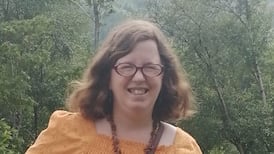An engineer has told Michael Scott’s trial that a suggestion his aunt Chrissie Treacy was run over twice by the teleporter Mr Scott was driving is “unsupported” and all her injuries could have been caused by “one movement”.
Dr Mark Jordan also disagreed with a garda report suggesting that the 76-year-old Ms Treacy should have been visible as Mr Scott reversed across his yard.
Mr Scott (58) of Gortanumera, Portumna, Co Galway has pleaded not not guilty to murdering Ms Treacy outside her home in Derryhiney, Portumna, Co Galway on April 27th, 2018. The prosecution case is that Mr Scott deliberately ran over Ms Treacy following a long-running dispute over land. Mr Scott’s lawyers have told the Central Criminal Court that her death was a tragic accident.
After the end of the prosecution case, Dr Jordan was called by defence counsel Paul Greene SC, and told him that he is a mechanical engineer who regularly advises on civil and criminal proceedings involving accidents with machinery. He said he was hired by Mr Scott’s lawyers but is independent and his duty is to the court and jury.
READ MORE
Dr Jordan disagreed with a number of points made in reports drawn up by a garda collision investigator and an engineer who previously gave evidence for the prosecution. Dr Jordan said that a suggestion that Ms Treacy was driven over twice appears to be “particularly unsupported”.
He said that, from early on, gardaí had decided that the teleporter went over Ms Treacy twice, but Dr Jordan found there was only one clear imprint over Ms Treacy’s trousers. He said that the other marks are “very difficult to interpret” but may have been left when Ms Treacy was in the upright position.
The trial has previously heard that Mr Scott told gardai he was reversing the teleporter across the yard when he felt a “thump” and thought he may have hit a trailer. He said he moved the machine forward to get it on level ground where it would not roll before getting down and finding Ms Treacy on the ground.
John Hayes, an engineer called by the prosecution, said a “flailing” injury to Ms Treacy’s left arm was “not consistent with a vehicle reversing over the deceased, coming to a stop and moving forward”. He said the injury was consistent with “a far more aggressive action and could be consistent with the rotation of the wheel while on the limb”. He explained that by “aggressive” he was not commenting on the driver’s intent but on the “high torque” of the vehicle which allowed it to change from reverse to forward “very quickly”.
One of the first gardaí on the scene previously gave evidence that there were rubber marks around Ms Treacy and the flesh was “ripped completely from her left forearm and strewn onto the yard in front of her hand”.
Dr Jordan’s view was that the degloving injury happened “in one motion as the machine was going back. There is no evidence of a second rollover of Ms Treacy in my opinion.”
He said the way her clothes were gathered towards her shoulders suggested that she was “struck and knocked down and hit the concrete hard, at which point the left rear wheel ran over her right hand and before Mr Scott had a chance to stop, the left front wheel travelled over her back while he was braking or stopping the machine.”
He said in his opinion that “one movement” of the back and front wheels accounts for all her injuries.
The injuries that caused Ms Treacy’s death, the witness said, did not require any unusual use of the teleporter. “Just driving the vehicle backwards will do it,” he said.
Dr Jordan disagreed with a garda statement that Ms Treacy would have been visible to Mr Scott as she walked the 45 metres from her door to where she was found. He said that if Mr Scott was not expecting anyone to be in the yard, he might not have looked across the yard before getting into the machine. Once in the cab, Dr Jordan said Mr Scott was reversing and looking over his right shoulder so the left portion to the rear, where Ms Treacy was, was not in his line of sight.
Dr Jordan described as subjective a test carried out by gardaí in which they placed an object the same height as Ms Treacy around the teleporter, and found that at all times it was visible from the cabin.
Before the close of the prosecution case, Detective Sergeant Paul Duane told Mr Greene that clothing worn by Mr Scott and the deceased on the day was examined by scientists at Forensic Science Ireland. There was no evidence of an exchange of DNA, blood or clothing fibres between the accused and the deceased, he said.
The trial continues next week in front of Ms Justice Caroline Biggs and a jury of eight men and seven women.












